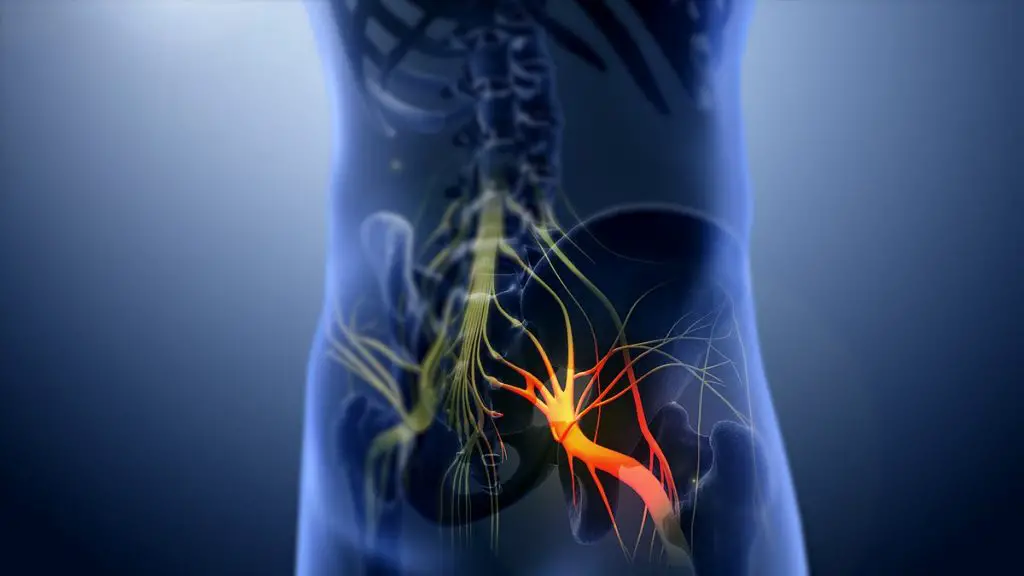La sciatica is a condition that results in pain, tingling, or numbness that radiates along the path of the sciatic nerve.
Le cider vinegar has long been used as a folk remedy for various ailments, including sciatica. In this article, we will see if the cider vinegar is an effective treatment for sciatica and how to use it safely.
Lumbar Spine Anatomy
La lumbar spine is the lower part of the spine that extends from the thoracic spine to the sacral spine. It consists of five vertebrae, which are numbered L1 to L5.
The vertebrae are separated by intervertebral discs and are connected to the ribs by facet joints. The spinal cord passes through the spinal canal, and nerves branch out from the spinal cord to innervate muscles and organs.
The vertebrae of the lumbar spine are larger than those of the cervical spine and thoracic, and they support more weight due to gravity.
The intervertebral discs are thicker and more resistant, which allows greater flexibility of the lumbar spine. The facet joints are also larger and stronger, providing stability while allowing some movement.
The lumbar spine is responsible for supporting most of the body weight and absorbing shock when walking or running. It also allows for a wide range of motion, including bending forwards, backwards, and to the sides.
Sciatic Nerve Anatomy
Le sciatic nerve is the longest and widest nerve in the human body, it starts from the lower back and goes down to the feet. It is made up of a combination of nerve fibers originating from the L4-S3 levels of the spinal cord.
These nerve fibers exit the spine through two main openings: the greater sciatic foramen and the lesser sciatic foramen.
Le sciatic nerve then passes under the piriformis muscle (a small muscle in the buttock) and crosses the sciatic notch (a hole in the pelvis) before dividing into two smaller nerves, the tibial nerve and the common peroneal nerve. These smaller nerves innervate (provide sensation to) different parts of the lower leg and foot.
Le sciatic nerve may be susceptible to a number of conditions, including sciatica and lumbosciatica. Sciatica is characterized by pain that radiates along the sciatic nerve, from the lower back to the foot.
This pain is often caused by compression or inflammation of one of the lumbar nerves (the nerves that make up the sciatic nerve).
Both conditions can be extremely debilitating, making it difficult or impossible to walk or stand for long periods of time.
Medical and alternative treatments
Treatments for a condition or injury can be divided into two categories: medical treatments and alternative treatments. These treatments may include:
- Medications ;
- Physiotherapy ;
- Osteopathy;
- Exercises;
- seepage;
There are also a variety of natural products which can be used to treat diseases. These products range from cider vinegar to grandmother's remedies.
While some people prefer to use only natural products, others choose to combine them with more traditional treatments.
5 exercises to relieve the symptoms of sciatica (in video)
Article reviewed and approved by Dr. Ibtissama Boukas, doctor specializing in family medicine You…
Calf pain: What if it came from the back? (Sciatica and more)
Article reviewed and approved by Dr. Ibtissama Boukas, doctor specializing in family medicine You…
Sciatica during pregnancy: Managing attacks (exercises)
Article reviewed and approved by Dr. Ibtissama Boukas, doctor specializing in family medicine On…
Lasègue sign: Test to detect sciatica or herniated disc
Article reviewed and approved by Dr. Ibtissama Boukas, doctor specializing in family medicine Le…
Sciatic nerve: Anatomy and route (Associated pathologies)
Article reviewed and approved by Dr. Ibtissama Boukas, doctor specializing in family medicine Le…
Sciatica and hip: what link? (explanation and advice)
The lower limbs provide locomotion, walking, jumping and body stability….
Apple cider vinegar, effective against pain related to the sciatic nerve?
Le cider vinegar is a popular home remedy for many different ailments, including sciatic nerve pain. Although there is no strong scientific evidence to support its use, many people swear by it. cider vinegar as an effective treatment.
There are several theories about how the cider vinegar may help relieve sciatic nerve pain. One of them suggests that the acids contained in the cider vinegar can help eliminate the buildup of inflammation around the nerve.
Another theory suggests that the cider vinegar can help block pain signals from the nerve.
How to use apple cider vinegar for relief?
To use the cider vinegar for sciatic nerve pain, mix two tablespoons of vinegar in a glass of water and drink it three times a day.
You can also apply a compress soaked in cider vinegar diluted on the painful area for fifteen minutes in a row. If you decide to try the cider vinegar for sciatic nerve pain, be sure to use organic, unfiltered vinegar to get the most benefit.
Other Natural Sciatica Treatments
Sciatica is a common condition that can cause lower back and leg pain. Although there are many traditional treatments for sciatica, such as pain relievers and physical therapy, some people may also benefit from other, more natural approaches. Here are some of the most popular natural treatments for sciatica:
- Chiropractic adjustments: Chiropractic adjustments are a common treatment for back pain in general, and they can also be effective for treating sciatica. A chiropractor uses their hands to manipulate the spine and relieve pressure on the sciatic nerve.
- Acupuncture: Acupuncture is a traditional Chinese method of healing that involves inserting fine needles into the skin at specific locations. Some people think it can help relieve pain by stimulating the nervous system.
- The massage: Massage therapy can be beneficial in treating sciatica by helping to relax muscles and relieve tension in the back.
- Heat and Ice: Applying heat or ice to the affected area can help reduce inflammation and pain.
- Stretches: Stretching the back and leg muscles can help relieve pressure on the sciatic nerve and improve flexibility.
- Yoga: Yoga is a form of exercise that involves stretches and postures that can help relieve tension in the back and improve flexibility.
Tools and accessories can also be used independently. They do not address the cause of the pain, but may provide temporary relief. Obviously, they are not as effective as an individualized approach from a healthcare professional.
Among the recommended products we have:
- Acupressure mat (with pillow)
- Shiatsu neck massager
- Manual neck massager
- massage gun
- Cervical massage cushion
- Cervical relaxation hammock
- Massage roller
- Foam roller (sport massage roller)
</span></p>
If you have sciatica, ask your doctor if any of these treatments might be right for you.
What about natural remedies?
Although they are not supported by solid scientific evidence, several natural products and home remedies are used to treat pain related to sciatica, in particular for their anti-inflammatory power.
Here is a non-exhaustive list of plants and essential oils that are effective in controlling pain and inflammation. The products are available on the site Country. Use promo code LOMBAFIT15 if you wish to obtain one of the following products, or any remedy aimed at relieving your symptoms and improving your quality of life:
- Turmeric. Thanks to its antioxidant and anti-inflammatory powers very powerful, turmeric is one of the most used plants in a culinary and therapeutic context. The composition of turmeric is essentially made of essential oils, vitamins (B1, B2, B6, C, E, K) and trace elements. But it is to its composition rich in curcumin and curcuminoids that we owe them and calm skin of this spice.
- Ginger. In addition to the special flavor it brings to the kitchen and its aphrodisiac properties, ginger is a root well known for its anti-inflammatory powers. the gingerol gives it its anti-inflammatory action. It is an active component acting on the inflammatory pain related to chronic joint inflammatory diseases, including rheumatoid arthritis, lupus, rheumatic diseases, etc. It has been proven that this active element is also effective in acting on the inflammation linked to arthritis and sciatica. Ginger also has other benefits thanks to its high potassium content and its richness in trace elements (calcium, magnesium, phosphorus, sodium) and vitamins (provitamin and vitamin B9).
- Omega-3s. Omega-3s are polyunsaturated fatty acids that play a very important role in the functioning of our body. They are provided by food in three natural forms: docosahexaenoic acid (DHA), alpha linolenic acid (ALA) and eicosapentaenoic acid (EPA). Beyond their action on the brain and the cardiovascular system, omega-3s prove very effective against inflammation. Indeed, they have the ability to act on the inflammatory mechanisms in osteoarthritis by slowing down cartilage destruction, thus they reduce the intensity of osteoarthritis pain. Sciatica, being most often linked to an inflammation secondary to a herniated disc, it can also respond to omega-3 provided it is consumed regularly.
- Lemon eucalyptus. Eucalyptus is a plant most often used in the form of herbal tea or essential oil. She would have anti-inflammatory effects which give it the ability to act on the bone and joint pain in general and the pain of sciatica in particular.
- wintergreen. Wintergreen is a shrub from which a very interesting essential oil is extracted. It is one of the most used essential oils in aromatherapy. This oil extracted from the shrub bearing the same name, is used in massage to relieve sciatica and act like a analgesic. Indeed, it provides a heating effect thanks to its ability toactivate blood circulation locally.
Conclusion
Le cider vinegar and other homeopathic remedies have been used for centuries to treat various medical conditions. Although there is a lack of scientific evidence supporting the use of these treatments, significant relief is often seen.
It is important to remember that these products should not replace medical treatment. If you plan to use cider vinegar or any other natural remedy, always inform your doctor and consult a homeopath if necessary.








